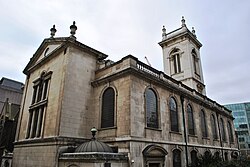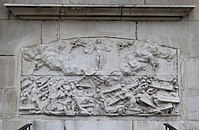St Andrew's, Holborn
| St Andrew, Holborn | |
|
London, Middlesex | |
|---|---|
| Status: | Guild church |

| |
| Church of England | |
| Diocese of London | |
| Location | |
| Location: | 51°31’2"N, 0°6’24"W |
| History | |
| Baroque | |
| Information | |
| Website: | standrewholborn.org.uk |
The Church of St Andrew, Holborn is a Church of England church on the north-western edge of the City of London, Middlesex, on Holborn within the Ward of Farringdon Without.
The church is designated a Grade I listed building.[1]
History
Roman and mediæval
Roman pottery was found on the site during 2001/02 excavations in the crypt. However, the first written record of the church itself is dated as 951 (dccccli) in a charter of Westminster Abbey, referring to it as the "old wooden church", on top of the hill above the River Fleet.[2] The Charter's authenticity has been called into question because the date is not within the reign of the King Edgar of England who is granting it. It may be that this is simply a scribal error and that the date should be '959' (dcccclix). A 'Master Gladwin', a priest, held it after the Norman Conquest and he assigned it to St Paul's Cathedral, but with the proviso that the advowson be granted at 12 pence a year to the Cluniac Order's, St Saviour's foundation of what was to become Bermondsey Abbey. This assignment dates between 1086 and 1089. In about 1200 a deed was witnessed by James, the Parson, Roger, his chaplain, Andrew, the Deacon and also Alexander his clerk. In 1280 one Simon de Gardino bequeathed funds towards the building of a belfry, it is assumed this would be stone and that there were due to be bells to be cast for it.[3]
In the Early Middle Ages the church is referred to as St Andrew Holburnestrate and later simply as St Andrew de Holeburn.[4]
In 1348, John Thavie, a local armourer, "left a considerable Estate towards the support of the fabric forever", a legacy which survived the Reformation, was invested carefully through the centuries, and still provides for the church's current upkeep. In the 15th century, the wooden church was replaced by a mediæval stone one.[5] On 8 July 1563, during a severe storm, the steeple of the church was struck and badly damaged by lightning.[6]
After being executed by hanging for the crime of serving at a Roman Catholic Mass, Swithin Wells was buried in the churchyard on 10 December 1591.[7]
16th to 18th century
The mediæval St Andrew's survived the 1666 Great Fire of London, saved by a last minute change in wind direction,[8] but was already in a bad state of repair and so was rebuilt by Christopher Wren anyway.[9] In what is his largest parish church, he rebuilt from the foundations (creating the present crypt) and gave the existing mediæval stone tower (the only mediæval part to survive) a marble cladding. Its rector from 1713 to 1724 was Henry Sacheverell, who is buried beneath the church's chancel.[10]
In 1741, the philanthropic sea captain Thomas Coram set up the Foundling Hospital for abandoned children in a house in nearby Hatton Garden. The following year, the charity moved to new premises in Bloomsbury and remained there until 1935.[11]
The church of St George the Martyr Holborn was built between 1703 and 1706, as a chapel of ease for the parish. It became a parish church in its own right in 1723.[12]
19th century

In 1808, writer William Hazlitt married Sarah Stoddart, with Charles Lamb as his best man, and Mary Lamb as a bridesmaid.
The twelve-year-old Benjamin Disraeli, the future Prime Minister, was received into the Christian Church here in 1817.
It was on the church's steps in 1828 that the surgeon William Marsden found a homeless girl suffering from hypothermia, and sought help for her from one of the nearby hospitals. However, none would take her in, and she died in Marsden's arms; the horror of the experience inspired him to establish the Royal Free Hospital for the poor and destitute. Today the hospital is located in Hampstead.

In the mid-19th century, the Holborn Valley Improvement Scheme bought up the church's North Churchyard.[13] Many of the bodies were re-interred: some in the crypt, and others at the City of London Cemetery in Ilford (the latter also being the destination for the bodies from the crypt when it was cleared in 2002–2003) to make way for the Holborn Viaduct, linking Holborn with Newgate, which was opened by Queen Victoria in 1869.[14]
As part of this improvement scheme the church received compensation to replace its assets, and the Gothic architect Samuel Sanders Teulon was commissioned to build a new rectory and court house on the south side of the church – this now operates as the offices for the foundation, the associated charities and the Archdeaconry of Hackney, as well as the rectory and the conference rooms. Teulon incorporated into the court room, the building's main room, a 17th-century fireplace.[15] This was from the 'Quest Room' for the 'below Bars' part of the parish, i.e. that lying outside the city boundary, sited as part of a block of buildings in the middle of the main street. This block was removed as part of the Holborn Viaduct improvements and explains why Holborn is so wide at this point.[16]
In Charles Dickens's Oliver Twist Bill Sykes looks up at this church's tower (an episode referenced by Iris Murdoch in Under the Net, though from where her character stands such a view is almost impossible).
20th century to present
During the London Blitz, on the night of 7 May 1941, the church was bombed and gutted by German bombs, leaving only the exterior walls and tower.[17] However, instead of demolition which sometimes occurred in similar cases, it was decided after a long delay that it would be restored "stone for stone and brick for brick" to Wren's original designs.



In 1955, the Foundling Hospital, which had originally been founded in the St Andrew's parish, sold its premises at Ashlyns School in Berkhamsted, Hertfordshire. It was decided to transfer a number of items from the Hospital chapel in Berkhamsted back to London, including the mortal remains of Thomas Coram, the Hospital founder, which were exhumed and placed in a tomb in St Andrew's. The casing of the organ, which had originally been given to the Foundling Hospital by George Frideric Handel, was also dismantled and installed in St Andrew's, along with the pulpit and the font.[11][18][19]
The church re-opened in 1961 as a non-parochial Guild Church intended for serving the local working rather than resident community which had declined as had the City's population as a whole.
In September 2017 controversy occurred when a London Fashion Week show which took place at the church included runway models sporting satanic images and symbols.[20]
Organ

The organ in St Andrew's is a 20th-century instrument in an 18th-century casing. It was built by Mander Organs in 1989 and is mounted in the west gallery. The upper part of the organ casing incorporates the original casework from the 1750 organ built for the Foundling Hospital chapel in Bloomsbury to a design by Handel. In 1935 it was installed in Ashlyns School chapel in Berkhamsted before being dismantled and re-installed in St Andrew, Holborn.[21][11][18]
Outside links
| ("Wikimedia Commons" has material about St Andrew's, Holborn) |
References
- ↑ National Heritage List 1064643: St Andrew Holborn
- ↑ Hibbert, C.; Weinreb, D.; Keay, J.: 'The London Encyclopaedia' (Pan Macmillan, 1983; rev 1993,2008) ISBN 978-1-4050-4924-5
- ↑ Barron, Caroline: 'The Parish of St Andrew Holborn' pp30–31 (1979)
- ↑ The Parish of St Andrew Holborn pp11–12 Caroline Barron, London 1979
- ↑ "London:the City Churches" Pevsner,N/Bradley,S : New Haven, Yale, 1998 ISBN 0-300-09655-0
- ↑ {{#invoke:citation/CS1|citation |CitationClass=encyclopaedia }}
- ↑ 'Acts of the English Martyrs' by John Hungerford Pollen, London, Burns and Oates Limited, 1891, p. 108.
- ↑ Samuel Pepys-The Shorter Pepys Latham,R(Ed) p484: Harmondsworth,1985 ISBN 0-14-009418-0
- ↑ Cobb, G: 'The Old Churches of London' (Batsford, 1942)
- ↑ Hibbert, C.; Weinreb, D.; Keay, J.: 'The London Encyclopaedia' (Pan Macmillan, 1983; rev 1993,2008) ISBN 978-1-4050-4924-5 page 710
- ↑ 11.0 11.1 11.2 Our History: Sir Christopher Wren rebuilds the church: St. Andrew Holborn
- ↑ National Heritage List 1245485: St George the Martyr, Holborn
- ↑ "The City Churches" Tabor, M. p63:London; The Swarthmore Press Ltd; 1917
- ↑ 'Farringdon Street, Holborn Viaduct and St. Andrew's church in 'Old and New London': Volume 2 (1878), pp. 496–513
- ↑ The Mantelpiece in the Courthouse of St Andrew's, Holborn, by Tony Sharp: in 'The Coat of Arms' the quarterly magazine of The Heraldry Society New Series Vol XV Spring 2004 no 205 pp193–203 with detailed photographs.
- ↑ The Farringdon Wards of the City of London; by Tony Sharp London 2000.
- ↑ "The Visitors Guide to the City of London Churches" Tucker,T: London, Friends of the City Churches, 2006 ISBN 0-9553945-0-3
- ↑ 18.0 18.1 Hastie, Scott (1999). Berkamsted: An Illustrated History. Kings Langley: Alpine Press. p. 57. ISBN 0-9528631-1-1.
- ↑ "The London Foundling Hospital". Archived from the original on 26 September 2017. https://web.archive.org/web/20170926132900/http://www.victorianweb.org/history/orphanages/coram5.html. Retrieved 26 September 2017.
- ↑ Adeogun, Eno. Church apologises for hosting satanic fashion show. Premier.org September 23, 2017. [1] Accessed 27 September 2017.
- ↑ "St Andrew's Holborn, London - Mander Organs". 27 January 2017. Archived from the original on 28 September 2017. https://web.archive.org/web/20170928111527/https://mander-organs.com/st-andrews-holborn/. Retrieved 28 September 2017.
